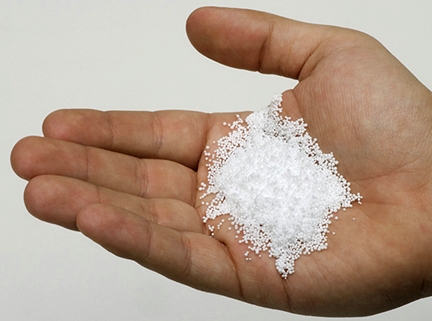By Susan Lutz
 Scrub some natural face cleanser on at the end of the day. Feels wonderful. A shea butter body cream can only be good, right? Read the ingredients. Many of the cosmetics on the shelf today contain microbeads. What’s a microbead? I hadn’t heard of them either. Yet, they are now so proliferate in many of the products we use, approximately 69 NGOs from 33 countries are supporting the campaign to end the use of the microbead, according to beatthemicrobead.org.
Scrub some natural face cleanser on at the end of the day. Feels wonderful. A shea butter body cream can only be good, right? Read the ingredients. Many of the cosmetics on the shelf today contain microbeads. What’s a microbead? I hadn’t heard of them either. Yet, they are now so proliferate in many of the products we use, approximately 69 NGOs from 33 countries are supporting the campaign to end the use of the microbead, according to beatthemicrobead.org.
What exactly is a microbead? Imagine a teeny, tiny bead of plastic. Now, image something smaller. Microbeads replace more natural ingredients, especially in health and body care products like scrubs, creams, and toothpaste. The tiny beads, less then 1mm, are composed of polyethylene, polypropylene, polymethyl methacrylate, or nylon, in short, plastic. Use a microbead for seconds, rinse, and it goes down the drain to stay in the environment forever. The cycle of water pulls the plastic fibers all the way to the oceans. They don’t break down. Instead, they mush into plastic-like goo; floating, unnoticed by a fish that eats a smaller fish – tasty, yet environmentally deadly. Catch the bigger fish and the contaminant ends up back on our table, in our mouths. See anyone pick up a tiny piece of plastic on the ground and eat it? That’s exactly what’s happening.
How did this happen? And, right under our nose? All of these ingredients are approved and “safe” to use. Safe bet companies are making money on the short-term benefit of making a product cheaper, getting it on the shelf quicker, and selling more than we really need. Natural ingredients take more time, most likely more investment – in the short run. (And, I’m not even talking about organic ingredients yet, just “natural” like putting in more real shea butter instead of cutting the real product with these tiny plastic beads.)
Step in a movement to end those tiny, terrible microbeads. Like so many other products we discover for the quick, availability and cheaper price, we buy it: plastic bags, the k-cup, or processed food. The ramifications of our choices always, not sometimes, but always come back to bite us in the bags and beads. Without seeing the long-term effect before we eat too much sugar or throw all or allow GMO modification of our food, we suffer the consequences of our choices and have to work to not only end the use of the danger, but also find ways to reinvent how to educate, make healthy choices, and show our children things like tiny microbeads just are a bad decision.
A movement has started to ban the microbead. Annie Leonard, founder of The Story of Stuff, began an idea to look at our prolific use of stuff. Her animated movies are short, great for anyone – I’ve showed them to my kids – and poignant. She’s always working on a solution. Pointing out the problem is one thing, doing something about yet another. Learn what products carry microbeads and stop using them. Check out sites that offer more information on microbeads and how to join a campaign to ban the bead.
So, let’s get started, below is a list of companies and products as posted from beatthemicrobead.org that contain microbeads. You can get the full list, for many countries, on their site.
A few examples of products with microbeads as listed by beathemicrobead.org:
Ahava: Dead Sea Essentials-Relaxing Almond Exfoliating Body Cleanser – Polyethylene (PE)
CVS Pharmacy: Oil Free Scrub – Polyethylene (PE)
Neutrogena/Johnson & Johnson: Deep clean gentle Scrub (oil free) – Polyethylene (PE)
Note the brands; be familiar with the all the chemical names of the microbead. Changing brands, really going natural or organic is a choice not just for better skin or whiter teeth, but a choice that makes a difference for our children and our planet.

